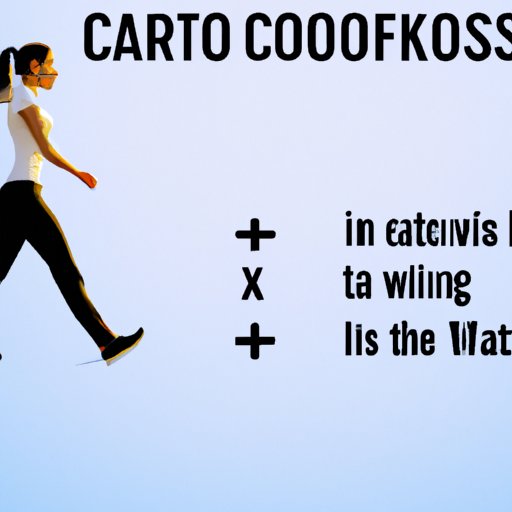Introduction
Cardio exercise, or aerobic exercise, is any physical activity that increases your heart rate and breathing. It can include activities such as running, swimming, biking, and walking. Walking is one of the most popular forms of cardio exercise because it’s low-impact, easy to do, and doesn’t require any special equipment. In this article, we’ll explore the benefits of walking as a cardio exercise, as well as how to make it part of your routine and tips for getting started.
Benefits of Walking as a Cardio Exercise
The American Heart Association recommends at least 150 minutes of moderate-intensity aerobic activity, such as brisk walking, each week for adults. According to the Centers for Disease Control and Prevention (CDC), walking has numerous health benefits, including reducing the risk of high blood pressure, type 2 diabetes, and coronary heart disease. In addition, walking can also help you maintain a healthy weight, improve your mood, and increase your energy levels.
How to Make Walking a Part of Your Cardio Routine
Getting started with walking as a cardio exercise is simple and straightforward. Here are some tips to help you make walking a regular part of your routine:
Setting Goals
Start by setting realistic goals for yourself. Begin with small goals and gradually work up to larger ones. For example, start by walking for 10 minutes a day and then work up to 30 minutes a day. You can also set goals in terms of distance, time, or frequency.
Incorporating Variety
Once you’ve established a routine, mix things up by incorporating different types of walking into your routine. Try walking in different environments, such as parks, trails, or on the beach. You can also vary your pace, from slow and relaxed to fast and intense.
Creating a Schedule
Creating a schedule will help keep you accountable and motivated. Choose days and times that work best for you and stick to them. Having a set time each day will help you make walking a habit.
Using Wearable Technology to Track Progress
Wearable fitness trackers can be very helpful in tracking your progress. They can monitor your steps, distance, heart rate, and calories burned, as well as provide other useful data. This information can help you stay motivated and reach your goals.
A Comparison of Walking vs Running for Cardio
When it comes to cardio exercise, walking and running are two of the most popular choices. But which one is better for you? Let’s take a look at the differences between the two:
Calories Burned
Running burns more calories than walking, but that doesn’t necessarily mean it’s the better choice. Depending on your fitness level and goals, you may find that walking is more beneficial for you. According to a study published in The Journal of Sports Science & Medicine, walking and running had similar effects on body composition and cardiovascular health.
Impact on Joints
Walking is a low-impact exercise, so it puts less strain on your joints and muscles than running. This makes it a great option for people who have joint issues or are recovering from an injury.
Time Commitment
Running can be done in a shorter amount of time than walking, making it a good choice for people who don’t have a lot of time to exercise. However, if you’re looking for a way to fit exercise into your day without sacrificing too much time, walking can be just as effective.

The Physiological Impact of Walking as a Cardio Exercise
Walking has numerous physiological benefits, including improved heart health, increased lung capacity, and weight loss. Here’s a closer look at these benefits:
Improved Heart Health
Regular walking can lower your risk of heart disease and stroke by improving your cholesterol levels and lowering your blood pressure. According to a study published in the American Journal of Preventive Medicine, walking for at least 30 minutes a day was associated with a 19% reduction in the risk of developing coronary heart disease.
Increased Lung Capacity
Walking can also improve your lung capacity by strengthening your respiratory muscles. This can help you breathe easier and improve your overall health.
Weight Loss
Regular walking can help you lose weight by burning calories and increasing your metabolic rate. To maximize the weight loss benefits of walking, combine it with a healthy diet and regular strength training.

Tips for Getting Started with Walking as a Cardio Exercise
If you’re new to walking as a cardio exercise, here are some tips to get you started:
Start Slow
When starting a new exercise routine, it’s important to start slow and build up gradually. Start with short walks and slowly increase the length and intensity as your fitness level improves.
Invest in the Right Gear
Having the right gear can make walking more enjoyable. Invest in a pair of comfortable shoes, a supportive sports bra, and a hat or visor to protect you from the sun. If you’re walking at night, make sure to wear reflective clothing.
Find Support
It can be helpful to have a friend or family member to walk with you. Not only will having someone to talk to make the time go by faster, but it can also help keep you motivated and accountable.

What You Need to Know About Walking as a Cardio Exercise
Before starting any new exercise routine, it’s important to understand the risks and benefits. Here are some things to keep in mind when it comes to walking as a cardio exercise:
Listen to Your Body
Your body is the best guide when it comes to exercise. If you’re feeling pain or discomfort, take a break and rest. If the pain persists, consult a doctor or physical therapist.
Stay Hydrated
It’s important to stay hydrated when exercising. Make sure to drink plenty of water before, during, and after your walk.

The Pros and Cons of Walking as a Cardio Exercise
Like any form of exercise, walking as a cardio exercise has both pros and cons. Here’s a look at the pros and cons of walking:
Pros
- Low-impact
- Easy to do
- Doesn’t require any special equipment
- Improves heart health
- Increases lung capacity
- Helps with weight loss
Cons
- Takes longer to burn the same number of calories as other forms of cardio exercise
- Can be uncomfortable in extreme temperatures
- May not be suitable for people with certain medical conditions
Conclusion
Walking is an effective form of cardio exercise with numerous benefits for your physical and mental health. It’s low-impact, easy to do, and doesn’t require any special equipment. To get started, set realistic goals, incorporate variety, create a schedule, and use wearable technology to track your progress. Remember to listen to your body and stay hydrated while walking. With its numerous benefits and few drawbacks, walking is a great choice for anyone looking to add more cardio into their routine.
(Note: Is this article not meeting your expectations? Do you have knowledge or insights to share? Unlock new opportunities and expand your reach by joining our authors team. Click Registration to join us and share your expertise with our readers.)
